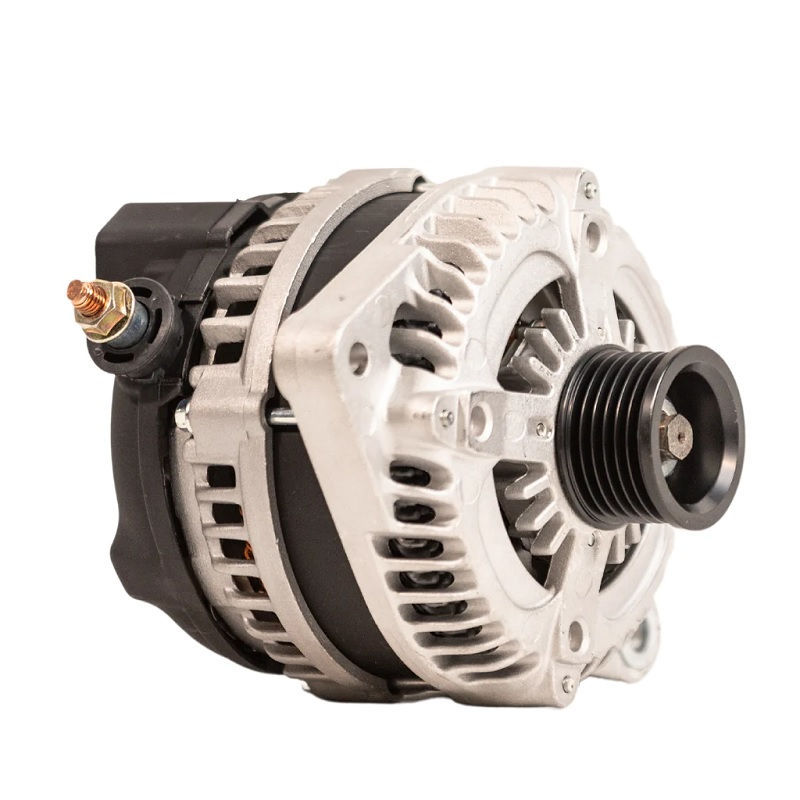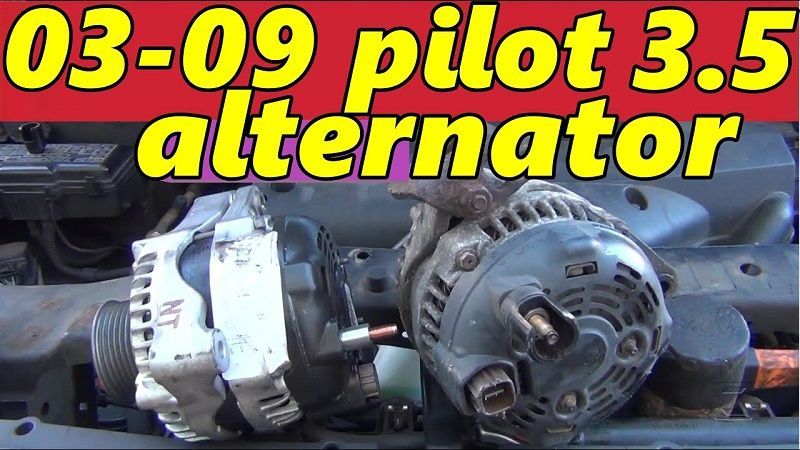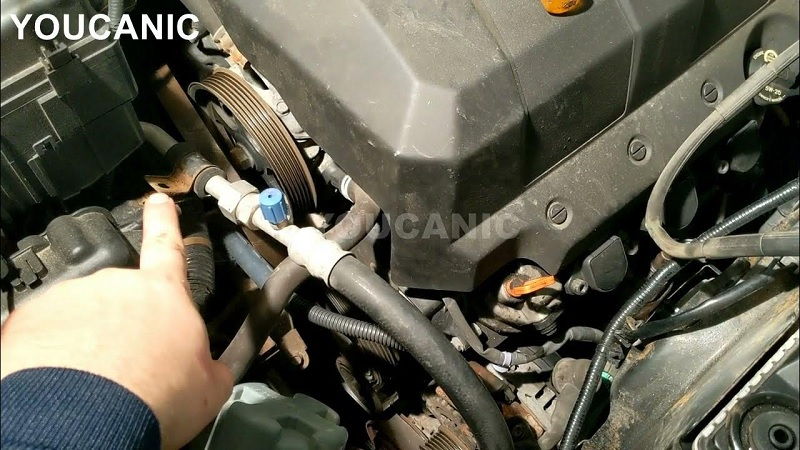This post contains affiliate links. This means I will make a commission at no extra cost to you should you click through and make a purchase [ “As an Amazon Associate, I earn from qualifying purchases.” ]. Read the full disclosure here.
2007 Honda Pilot Alternator GuideMechanic.Com The alternator is a critical component of the charging system in any vehicle, including the 2007 Honda Pilot.
It plays a vital role in generating electrical power to keep the battery charged and supply electricity to various electrical systems while the engine is running.
Understanding how the alternator works and knowing when it may need to be replaced are essential for maintaining the reliability and performance of your Honda Pilot.
In this comprehensive guide, we will delve into the intricate details of the 2007 Honda Pilot alternator, covering its functions, common issues, signs of failure, testing methods, replacement procedures, maintenance tips, potential upgrades, troubleshooting advice, and the benefits of professional services.
See Also: 2007 Honda Civic Spark Plugs
Whether you are a DIY enthusiast or prefer to rely on experts, this article aims to provide you with all the knowledge you need to ensure your Honda Pilot’s alternator operates flawlessly for years to come.
How Does an Alternator Work?
Understanding the Basic Principles

The alternator is driven by a belt connected to the engine’s crankshaft. It consists of several key components, including a rotor, stator, diodes, voltage regulator, and pulley.
When the engine is running, the rotational motion of the crankshaft drives the alternator’s rotor, which is equipped with wire windings.
As the rotor spins inside the stator, a magnetic field is created, inducing an alternating current (AC) in the stator windings.
The AC produced by the stator is then converted into direct current (DC) by the diodes. The DC power is then regulated by the voltage regulator, ensuring a steady supply of electricity at the appropriate voltage to charge the battery and power the electrical systems in the vehicle.
The Role of the Voltage Regulator
The voltage regulator is a crucial component of the alternator. Its primary function is to regulate the output voltage to a specific level, typically around 14 volts, to ensure the battery is charged properly and prevent overcharging.
The voltage regulator achieves this by controlling the amount of current flowing through the rotor windings, which consequently adjusts the strength of the magnetic field generated by the rotor.
By continuously monitoring the battery voltage and electrical load, the voltage regulator adjusts the current supplied to the rotor, maintaining a stable voltage output regardless of the engine speed or electrical demand.
Benefits of an Alternator over a Generator
In older vehicles, generators were commonly used to generate electricity. However, alternators have largely replaced generators due to several advantages they offer.
Alternators are more efficient, compact, and capable of producing higher currents at lower engine speeds.
Unlike generators, which require brushes and commutators for current transfer, alternators utilize diodes for rectification, resulting in less maintenance and improved reliability.
Additionally, the regulated output voltage of alternators ensures a consistent supply of power, preventing overcharging and extending the life of the battery and electrical components.
Understanding the 2007 Honda Pilot Alternator
Design and Specifications
Check out this EPAuto CP134 (CF10134) Premium Cabin Air Filter includes Activated Carbon

The 2007 Honda Pilot alternator is specifically designed to meet the electrical demands of this particular vehicle model.
It typically features a compact design, allowing for easy installation within the engine compartment. The alternator’s output capacity may vary, but it generally provides a sufficient charging current to keep the battery adequately charged and power all the electrical systems in the Honda Pilot, including the lights, audio system, climate control, and various onboard electronics.
Compatibility and Interchangeability
It’s important to note that the 2007 Honda Pilot alternator may not be interchangeable with alternators from other Honda models or model years.
See Also: 2007 Ford Focus Spark Plugs
The design, mounting points, electrical connections, and output specifications may vary between different vehicle models and years.
Therefore, when replacing the alternator, it is crucial to ensure you are purchasing a compatible unit specifically designed for the 2007 Honda Pilot.
Signs of Alternator Failure
Dim Headlights and Electrical System Malfunctions

One of the most common signs of alternator failure is dim headlights. When the alternator fails to generate sufficient electrical power, the headlights may appear noticeably dimmer than usual, especially at lower engine speeds or when additional electrical loads are applied, such as air conditioning or high-beam headlights.
In addition to dim headlights, you may also experience issues with other electrical systems, such as flickering interior lights, slow power window operation, or erratic radio behavior.
These symptoms indicate a potential problem with the alternator’s ability to supply adequate power to the vehicle’s electrical systems.
Strange Noises and Smells
A failing alternator may produce unusual noises or emit strange odors. If you hear a grinding, whining, or squealing noise coming from the front of the engine, it could indicate a worn-out or damaged alternator bearing.
Additionally, a burning smell, similar to that of an electrical fire, may be present if the alternator is overheating due to internal issues or excessive electrical load.
Any unusual noises or smells should be promptly investigated to determine the source of the problem and prevent further damage.
Battery-Related Issues
Since the alternator plays a vital role in keeping the battery charged, a failing alternator directly impacts the battery’s performance.
If you notice a sudden decrease in battery charge or find yourself frequently needing to jump-start the vehicle, it could be a sign of alternator failure.
Additionally, a weak alternator may not provide sufficient charging current to the battery, leading to a gradual loss of battery capacity and a shortened lifespan.
Monitoring the battery’s voltage and keeping track of any recurring battery-related issues can help identify potential alternator problems.
Dashboard Warning Lights

Modern vehicles are equipped with sophisticated onboard computer systems that monitor various vehicle components, including the alternator.
When the alternator fails or exhibits abnormal behavior, the vehicle’s computer may detect the issue and illuminate the battery or charging system warning light on the dashboard. This warning light serves as an early indicator of potential alternator problems and should not be ignored.
Testing the Alternator
Voltage Testing
To determine the health of your 2007 Honda Pilot alternator, you can perform a simple voltage test using a multimeter. Start by ensuring the vehicle’s engine is off and the ignition is in the “off” position.
Connect the multimeter’s positive lead to the positive terminal of the battery and the negative lead to the negative terminal.
The multimeter should display the battery’s voltage, which should typically be around 12.6 volts for a fully charged battery.
See Also: 2008 Honda Civic Spark Plugs
Start the engine and rev it to around 2000 RPM while observing the multimeter’s voltage reading. The voltage should increase to around 13.5 to 14.5 volts, indicating that the alternator is producing the necessary charging voltage.
Load Testing
While voltage testing provides a general idea of the alternator’s output, it may not accurately reflect its ability to handle high electrical loads. Performing a load test helps evaluate the alternator’s performance under increased demand.
Start by turning on various electrical systems, such as headlights, air conditioning, and rear defroster, to simulate a high electrical load.
With the engine running, again measure the battery voltage using the multimeter. If the voltage remains within the acceptable range (around 13.5 to 14.5 volts) despite the increased load, it indicates that the alternator is capable of supplying adequate power even under high-demand conditions.
Replacing the Alternator
Preparation and Safety Measures

Before replacing the alternator, ensure the vehicle’s engine is turned off and the negative battery cable is disconnected to prevent any electrical mishaps.
It is also important to take note of the alternator’s mounting position, electrical connections, and belt routing to facilitate the installation of the new alternator.
Removing the Old Alternator
To remove the old alternator, start by loosening the serpentine belt tensioner using an appropriate wrench or tool. Once the tension is relieved, carefully slide the belt off the alternator pulley.
Next, disconnect the electrical connections attached to the alternator, including the main power wire and any other small wires or connectors.
Finally, remove the mounting bolts that secure the alternator to the engine block or bracket, taking care not to drop them into inaccessible areas of the engine compartment.
Installing the New Alternator
When installing the new alternator, ensure that it matches the specifications and design of the original unit. Begin by positioning the alternator in its designated location, aligning the mounting holes with the corresponding holes on the engine block or bracket.
Reinstall the mounting bolts, tightening them to the manufacturer’s recommended torque specification. Next, reconnect the electrical connections, making sure they are secure and properly seated.
Lastly, route the serpentine belt back onto the alternator pulley, following the correct routing diagram, and use the tensioner to apply tension to the belt.
Maintenance Tips for Prolonging Alternator Life
Regular Inspections
Performing visual inspections of the alternator can help identify early signs of wear or damage. Check for any loose connections, frayed wires, or signs of leakage around the alternator.
Inspect the serpentine belt for signs of wear,such as cracks or fraying. If any issues are detected, they should be addressed promptly to prevent further damage to the alternator or other components of the charging system.
Cleaning and Corrosion Prevention
Over time, dirt, dust, and debris can accumulate on the alternator, affecting its performance and potentially causing overheating.
See Also: 2008 Honda Accord Spark Plugs
Regularly cleaning the alternator with a soft brush or compressed air can help remove any buildup and ensure proper airflow.
Additionally, keeping the alternator and its surrounding area free from corrosion can help maintain good electrical connections.
Applying dielectric grease to electrical connections can help prevent corrosion and ensure a reliable connection.
Belt Tension and Condition
The serpentine belt that drives the alternator should be properly tensioned to prevent slippage, which can lead to insufficient charging and premature alternator failure.
Refer to the vehicle’s manual or manufacturer’s specifications for the correct tensioning procedure. Regularly inspect the belt for signs of wear, cracks, or fraying, and replace it if necessary.
A worn or damaged belt can hamper the performance of the alternator and should be addressed promptly.
Battery Maintenance
Maintaining a healthy battery is essential for the proper functioning of the alternator. Regularly check the battery’s voltage using a multimeter and ensure it remains within the recommended range.
If the battery consistently shows low voltage readings or struggles to hold a charge, it may need to be replaced.
Additionally, keeping the battery terminals clean and free from corrosion can help ensure a good electrical connection between the battery and alternator.
Proper Electrical Load Management
Excessive electrical loads can strain the alternator and potentially lead to premature failure. Avoid using unnecessary electrical accessories or systems simultaneously, as this puts additional strain on the alternator.
Be mindful of the electrical load when adding aftermarket accessories, such as high-powered audio systems or additional lights, and ensure that the alternator can handle the increased demand. Consider upgrading the alternator or using a secondary battery if needed.
Regular Battery Checks
Monitoring the battery’s state of charge and performing regular maintenance, such as checking the electrolyte levels in conventional batteries or monitoring the voltage in maintenance-free batteries, can help identify any potential issues.
A weak or failing battery can place additional strain on the alternator, leading to reduced performance and potential alternator failure. By addressing battery-related issues promptly, you can help prolong the life of the alternator.
Upgrading Your Alternator
Enhanced Electrical Performance
Check out this RSLOVE Women Christmas Lingerie Set 3 Piece Sexy Santa Babydoll Red Chemise with Belt and Cuffs
If you frequently use high-demand electrical accessories or plan on adding aftermarket modifications to your 2007 Honda Pilot, upgrading the alternator can provide enhanced electrical performance.
A higher output alternator can supply more power to meet increased demand, ensuring that all electrical systems operate optimally without straining the charging system.
Choosing the Right Alternator Upgrade
When considering an alternator upgrade, it is crucial to select an alternator that is compatible with the 2007 Honda Pilot’s electrical system and mounting points.
Consult with reputable automotive suppliers or manufacturers to determine the appropriate alternator upgrade for your specific needs.
Consider factors such as output capacity, compatibility with the existing wiring and voltage regulator, and any necessary modifications or adjustments required for installation.
Professional Installation
While some experienced DIY enthusiasts may choose to install an upgraded alternator themselves, it is recommended to seek professional installation for optimal results.
Professional technicians have the expertise and specialized tools to ensure a proper and reliable installation, minimizing the risk of electrical issues or damage to the vehicle.
Additionally, professional installation often comes with warranties, providing peace of mind and protection in case of any unforeseen issues.
Frequently Asked Questions
Can a failing alternator drain the battery?
Yes, a failing alternator can lead to a drained battery. If the alternator is not generating enough power to keep the battery charged, the vehicle’s electrical systems will draw power directly from the battery.
Over time, this can deplete the battery’s charge, resulting in a drained battery and potential starting issues.
How long does a Honda Pilot alternator typically last?
The lifespan of an alternator can vary depending on various factors, including driving conditions, electrical load, and maintenance.
In general, a well-maintained alternator in a Honda Pilot can last anywhere from 80,000 to 150,000 miles.
See Also: Spark Plug Replacement Cost Jiffy Lube
However, if you notice any signs of alternator failure or experience electrical issues, it is important to have it inspected and serviced promptly.
Can I drive with a faulty alternator?
Continuing to drive with a faulty alternator is not recommended. A failing alternator can lead to a drained battery, which can leave you stranded and unable to start your vehicle.
Additionally, a faulty alternator may cause electrical issues, such as intermittent power loss or malfunctioning electrical systems, which can compromise your safety and the vehicle’s performance.
How much does it cost to replace a Honda Pilot alternator?
The cost of replacing a Honda Pilot alternator can vary depending on several factors, including the brand of the alternator, the labor charges of the service center, and any additional components or services required.
On average, the cost for a new alternator and installation can range from $300 to $700. It is advisable to obtain quotes from multiple reputable service centers to ensure a fair price and quality service.
Troubleshooting Common Alternator Issues
Abnormal Charging Rates
If you notice that the alternator is consistently overcharging or undercharging the battery, it may indicate a problem with the voltage regulator or other internal components.
Consult a professional technician to diagnose and resolve the issue to prevent further damage to the battery or electrical systems.
Voltage Fluctuations
Fluctuating voltage readings on the battery or dashboard voltmeter can be a sign of a faulty alternator or loose electrical connections.
Inspect the alternator and wiring connections for any signs of damage or looseness. If the issue persists, it is recommended to seek professional assistance for a thorough diagnosis.
Connection Issues
Loose or corroded electrical connections can result in poor electrical conductivity and lead to alternator malfunctions.
Regularly inspect the alternator’s electrical connections and clean or tighten them as necessary. Applying dielectric grease to the connections can help prevent corrosion and ensure a reliable connection.
Professional Alternator Services
The Benefits of Professional Services
Seeking professional alternator services offers several advantages. Professional technicians have the knowledge, experience, and specialized tools to accurately diagnose alternator issues and provide appropriate solutions.
Additionally, professional service centers often offer warranties on parts and labor, providing added peace of mind and protection against any unforeseen problems.
Choosing a Reliable Automotive Service Center
When selecting an automotive service center for alternator repairs or replacements, consider factors such as their reputation, experience, and certifications.
Look for service centers that specialize in Honda vehicles or have extensive experience working with alternators.
Reading customer reviews and seeking recommendations from trusted sources can help you choose a reliable and reputable service center.
In conclusion, the 2007 Honda Pilot alternator is a crucial component of the vehicle’s charging system, responsible for generating electrical power and supplying electricity to various electrical systems.
Understanding its functions, signs of failure, testing methods, replacement procedures, maintenance tips, potential upgrades, troubleshooting advice, and the benefits of professional services is essential for maintaining the reliability and performance of your Honda Pilot.
By following the guidelines provided in this comprehensive guide, you can ensure that your Honda Pilot’s alternator operates flawlessly, providing a reliable source of power for years to come.
- 2007 Honda Pilot Alternator - September 17, 2023
